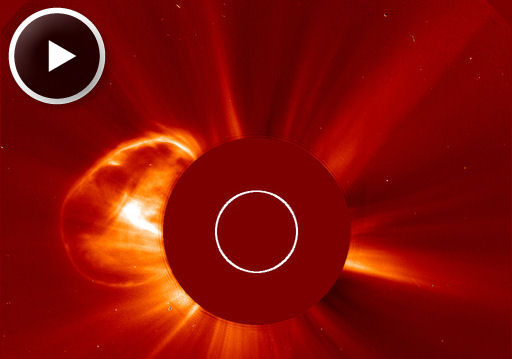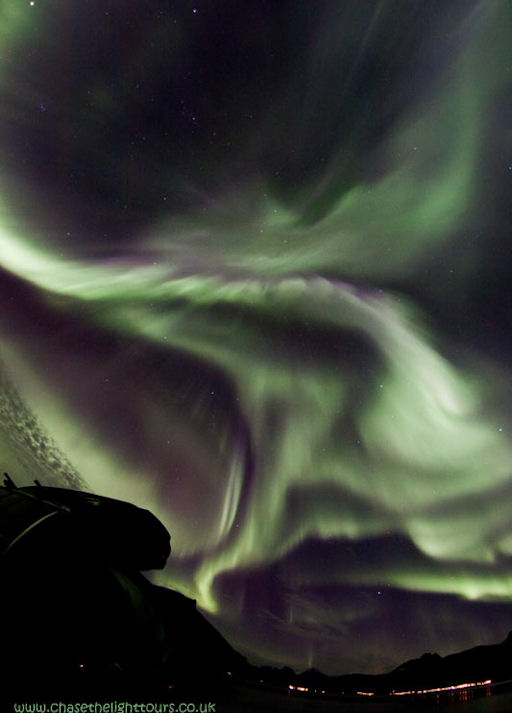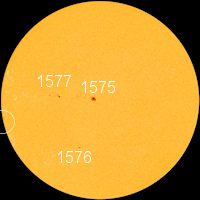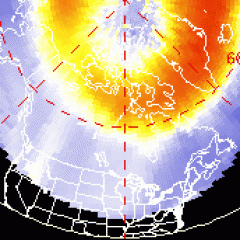SLIGHT CHANCE OF FLARES: NOAA forecasters estimate a 10% to 15% chance of M-class solar flares during the next 24 hours. The likely source would be sunspot AR1575, near the center of the solar disk. The odds are low, but if a flare occurs in AR1575, it will be Earth-directed. Solar flare alerts: text, voice.
FARSIDE EXPLOSION: An active region on the farside of the sun exploded on Sept. 23rd, hurling a bright coronal mass ejection over the sun's eastern limb. Orbiting at the L1 Lagrange Point, the Solar and Heliospheric Observatory (SOHO) recorded the expanding cloud:
The cloud is not heading for Earth. Nor is any other planet in the line of fire. In a few days, however, the sun's rotation will turn the blast site toward Earth. After that, eruptions could become geoeffective.
You can monitor farside explosions and track this active region on your smartphone or iPad: Download the 3D Sun, courtesy of NASA's Heliophysics Division.
Realtime Space Weather Photo Gallery
AUTUMN LIGHTS: The onset of northern autumn means it's aurora season. For reasons researchers don't fully understand, equinoxes are the best times to see Northern Lights. And, right on cue, the Arctic Circle is glowing. Marianne Bergli sends this picture of auroras shimmering directly above Storfjord, Norway:
"Last night it was difficult to select [which part of the sky to photograph]. The auroras were dancing everywhere," says Bergli. "Eventually I was just lying on my back looking up. It was absolutely, unbelievable wonderful."
As the week begins, the solar wind velocity is low (~350 km/s), but at this time of year it only takes a gentle gust to ignite bright auroras around the Arctic Circle. High-latitude sky watchers should remain alert for auroras. Aurora alerts: text, voice.

![]()
Solar wind
speed: 357.3 km/sec
density: 2.9 protons/cm3
explanation | more data
Updated: Today at 1556 UT
![]()
X-ray Solar Flares
6-hr max: C1 1542 UT Sep24
24-hr: C1 1542 UT Sep24
explanation | more data
Updated: Today at: 1559 UT
![]()
![]()
![]()
Daily Sun: 24 Sep 12
![]()
![]()
A new sunspot is emerging at the circled location. Sunspot 1575 poses a slight threat for M-class solar flares. Credit: SDO/HMI
![]()
![]()
![]()
Sunspot number: 57
What is the sunspot number?
Updated 24 Sep 2012
Spotless Days
Current Stretch: 0 days
2012 total: 0 days (0%)
2011 total: 2 days (<1%)
2010 total: 51 days (14%)
2009 total: 260 days (71%)
Since 2004: 821 days
Typical Solar Min: 486 days
Update 24 Sep 2012
The Radio Sun
10.7 cm flux: 125 sfu
explanation | more data
Updated 24 Sep 2012
![]()
![]()
![]()
Current Auroral Oval:
![]()
Switch to: Europe, USA, New Zealand, Antarctica
Credit: NOAA/POES
![]()
![]()
![]()
Planetary K-index
Now: Kp= 1 quiet
24-hr max: Kp= 1 quiet
explanation | more data
![]()
Interplanetary Mag. Field
Btotal: 4.8 nT
Bz: 0.7 nT south
explanation | more data
Updated: Today at 1556 UT
![]()
![]()
![]()
Coronal Holes: 24 Sep 12
![]()
![]()
There are no large coronal holes on the Earth side of the sun. Credit: SDO/AIA.






